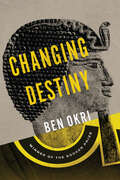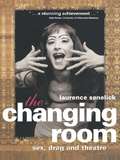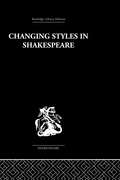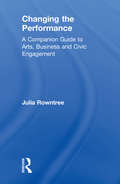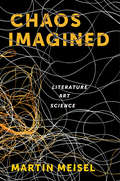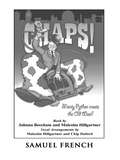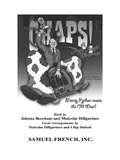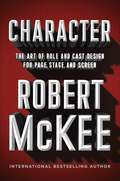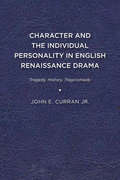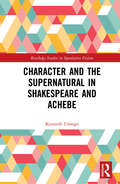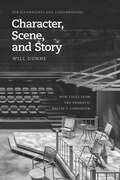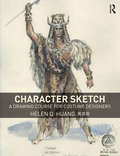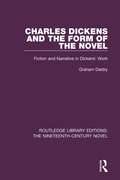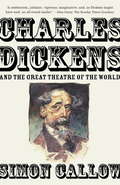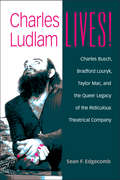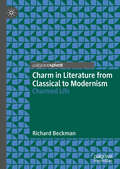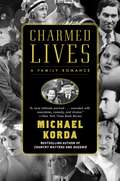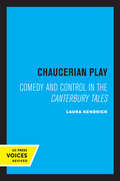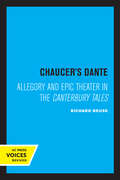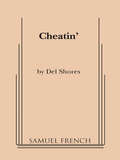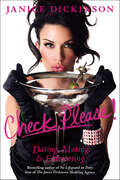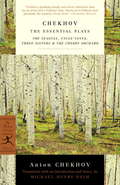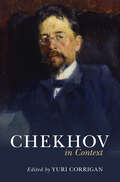- Table View
- List View
Changing Destiny
by Ben OkriA bold new adaptation of the 4,000-year-old Egyptian poem about Warrior King Sinuhe that captures the essence of civilization and the complexities of immigration, from the Booker Prize–winning author.Forced to flee Egypt, Sinuhe is captured as a prisoner of war by the foreign Kingdom of Retenu. Stripped of status and tormented by memories, Sinuhe will need great force of will to survive as a stranger in an unknown land. But can he transcend the mysterious powers of Egypt and the tribulations of exile?With two actors incarnating a multitude of characters, Ben Okri&’s play recreates one of the world&’s first known stories, a timeless tale about the strength of the human spirit.
The Changing Room: Sex, Drag and Theatre (Gender in Performance)
by Laurence SenelickThe answers to these questions - and much, much more - are to be found in The Changing Room , which traces the origins and variations of theatrical cross-dressing through the ages and across cultures. It examines: * tribal rituals and shamanic practices in the Balkans and Chinese-Tibet * the gender-bending elements of Greek and early Christian religion * the homosexual appeal of the boy actor on the traditional stage of China, Japan and England * the origins of the dame comedian, the principal boy, the glamour drag artiste and the male impersonator * artists such as David Bowie, Boy George, Charles Ludlam, Dame Edna Everage, Lily Savage, Candy Darling, Julian Clary and the New York Dolls. Lavishly illustrated with unusual and rare pictures, this is the first ever cross-cultural study of theatrical transvestism. It is a must for anyone interested in cross-dressing, theatre, and gender.
Changing Styles in Shakespeare
by Ralph BerryFirst published in 1981. Each of Shakespeare's plays is in a continuous state of development in performance. This book examines major changes whilst focusing on six plays in detail: Coriolanus, Measure for Measure, Troilus and Cressida, Henry V, Hamlet and Twelfth Night. Changing Styles in Shakespeare looks at representative and key productions to trace the evolution of each play on today's stage, illustrating how production changes relate to a changed perception of the play, and thus to shifts in social attitudes. It singles out the salient features of many productions, paying special attention to reviews and prompt books.
Changing the Performance: A Companion Guide to Arts, Business and Civic Engagement
by Julia RowntreeA result of many years of research and practice, Changing the Performance is a book about the arts and about business, and the interplay between the two. Julia Rowntree gives a fascinating account of her experiences forging the business sponsorship campaign at the London International Festival of Theatre (LIFT). Raising intriguing questions, this book proposes that fundraising for the arts is much more than simply a function for generating income. It fulfils an ancient social role of connection across levels of power, expertise, culture, gender and generation. Rowntree describes why these dynamics are vital to society's ability to adapt. Changing the Performance is an inspiring manual for arts practitioners concerned with the relationship between business, the arts and wider society, and particularly those engaged in fundraising.
Chaos Imagined: Literature, Art, Science
by Martin MeiselThe stories we tell in our attempt to make sense of the world—our myths and religion, literature and philosophy, science and art—are the comforting vehicles we use to transmit ideas of order. But beneath the quest for order lies the uneasy dread of fundamental disorder. True chaos is hard to imagine and even harder to represent. In this book, Martin Meisel considers the long effort to conjure, depict, and rationalize extreme disorder, with all the passion, excitement, and compromises the act provokes.Meisel builds a rough history from major social, psychological, and cosmological turning points in the imagining of chaos. He uses examples from literature, philosophy, painting, graphic art, science, linguistics, music, and film, particularly exploring the remarkable shift in the eighteenth and nineteenth centuries from conceiving of chaos as disruptive to celebrating its liberating and energizing potential. Discussions of Sophocles, Plato, Lucretius, Calderon, Milton, Haydn, Blake, Faraday, Chekhov, Faulkner, Wells, and Beckett, among others, are matched with incisive readings of art by Brueghel, Rubens, Goya, Turner, Dix, Dada, and the futurists. Meisel addresses the revolution in mapping energy and entropy and the manifold effect of thermodynamics. He then uses this chaotic frame to elaborate on purpose, mortality, meaning, and mind.
Chaps!
by Jahnna Beecham5m, 1f -- Musical Comedy \ Unit Set \ Whoa, Brittania! Panic at the BBC! The year is 1944, America's favorite singing cowboy Tex Riley and his troupe are late for a special broadcast at the BBC in London. Out of desperation, Mabel, their tour manager, and Miles, the frantic young producer, grab whomever they can -- a snobby announcer, an amiable sound man, a passing soap opera actor -- slap them into costume, hand them scripts (after all, it's radio!) and shove them in front of the studio audience. The resulting performance is one England will never forget. Also available in a special holiday version, Chaps! A Jingle Jangle Christmas. \ "...Combine Monty Python and Tex Ritter, and you get a bloody funny singing buckaroo!" -- Herald News, Klamath Falls, OR
Chaps! A Jingle Jangle Christmas
by Jahnna Beecham5m, 2f \ Holiday Musical Comedy \ All Groups -- Unit Set \ Whoa, Brittania! Panic at the BBC! It's Christmas Eve, 1944. America's favorite singing cowboy Tex Riley and his troupe are late for a special holiday broadcast at the BBC. Out of desperation, Mabel, their tour manager, and Miles, the frantic young producer, grab whomever they can -- a snobby announcer, an amiable soundman, a passing soap opera actor -- slap them into costume, hand them scripts (after all, it's radio!) and shove them in front of the studio audience. The resulting performance is one England will never forget full of Christmas songs and quirky cowboy tunes. This is the holiday version of Chaps! \ "...Combine Monty Python and Tex Ritter, and you get a bloody funny singing buckaroo!" -- Herald News , Klamath Falls, OR
Character: The Art of Role and Cast Design for Page, Stage, and Screen
by Robert MckeeThe long-awaited third volume of Robert McKee&’s trilogy on the art of fiction. Following up his perennially bestselling writers' guide Story and his inspiring exploration of the art of verbal action in Dialogue, the most sought-after expert in the storytelling brings his insights to the creation of compelling characters and the design of their casts. CHARACTER explores the design of a character universe: The dimensionality, complexity and arcing of a protagonist, the invention of orbiting major characters, all encircled by a cast of service and supporting roles.
Character and the Individual Personality in English Renaissance Drama: Tragedy, History, Tragicomedy (G - Reference, Information And Interdisciplinary Subjects Ser.)
by John E. CurranCharacter and the Individual Personality in English Renaissance Drama: Tragedy, History, Tragicomedy studies instantiations of the individualistic character in drama, Shakespearean and non-Shakespearean, and some of the Renaissance ideas allowing for and informing them. Setting aside such fraught questions as the history of Renaissance subjectivity and individualism on the one hand and Shakespearean exceptionalism on the other, we can find that in some plays, by a range of different authors and collaborators, a conception has been evidenced of who a particular person is, and has been used to drive the action. This evidence can take into account a number of internal and external factors that might differentiate a person, and can do so drawing on the intellectual context in a number of ways. Ideas with potential to emphasize the special over the general in envisioning the person might come from training in dialectic (thesis vs hypothesis) or in rhetoric (ethopoeia), from psychological frameworks (casuistry, humor theory, and their interpenetration), or from historiography (exemplarity). But though they depicted what we would call personality only intermittently, and with assumptions different from our own about personhood, dramatists sometimes made a priority of representing the workings of a specific mind: the patterns of thought and feeling that set a person off as that person and define that person singularly rather than categorically. Some individualistic characters can be shown to emerge where we do not expect, such as with Fletcherian personae like Amintor, Arbaces, and Montaigne of The Honest Man’s Fortune; some are drawn by playwrights often uninterested in character, such as Chapman’s Bussy D’Ambois, Jonson’s Cicero, and Ford’s Perkin Warbeck; and some appear in being constructed differently from others by the same author, as when Webster’s Bosola is set in contrast to Flamineo, and Marlowe’s Faustus is set against Barabas. But Shakespearean characters are also examined for the particular manner in which each troubles the categorical and exhibits a personality: Othello, Good Duke Humphrey, and Marc Antony. Published by University of Delaware Press. Distributed worldwide by Rutgers University Press.
Character and the Supernatural in Shakespeare and Achebe (Routledge Studies in Speculative Fiction)
by Kenneth UsongoThrough mainly a New Historicist critical approach, this book explores how Shakespeare and Achebe employ supernatural devices such as prophecies, dreams, gods/goddesses, beliefs, and divinations to create complex characters. Even though these features indicate the preponderance of the belief in the supernatural by some people of the Elizabethan, Jacobean, and traditional Igbo societies, Shakespeare and Achebe primarily use the supernatural to represent the states of mind of their protagonists. Both writers appropriate supernatural features to mirror tragic flaws such as ambition, arrogance, impulsiveness, and fear that contribute to the downfall of Macbeth, Lear, Okonkwo, and Ezeulu. We relate to some of these characters because they project our inner minds, principal drives that may be hidden within us. Therefore, Shakespeare and Achebe’s preoccupation with the supernatural adds subtlety to their characterization and enhances their readability by situating their art beyond time, place, or particularity.
Character Costume Figure Drawing: Step-by-Step Drawing Methods for Theatre Costume Designers
by Tan HuaixiangCharacter Costume Figure Drawing is an essential guide that will improve your drawing skills and costume renderings. Step-by-step visuals illustrate the how-tos of drawing body parts, costumes, accessories, faces, children, and different character archetypes, such as maternal, elderly, sassy, sexy, and evil. By focusing on the foundations of drawing bodies, including body proportion, bone structure, body masses, facial expressions, and appendages, this guide shows you how to develop sketches from stick figures to full-blown characters. The third edition features a new chapter, Digital Mixed Media Costume Rendering. This chapter introduces the basic usages of Photoshop tools to enhance and improve costume designs, in order to provide easy delivery design ideas to the director and design team, provide easy changes and alterations during the design process, virtually apply actual fabric swatches over costume sketches, and help visualize lighting effects.
Character, Scene, and Story: New Tools from the Dramatic Writer's Companion (Chicago Guides to Writing, Editing, and Publishing)
by Will DunneWill Dunne first brought the workshop experience down to the desk level with The Dramatic Writer’s Companion, offering practical exercises to help playwrights and screenwriters work through the problems that arise in developing their scripts. Now writers looking to further enhance their storytelling process can turn to Character, Scene, and Story. Featuring forty-two new workshop-tested exercises, this sequel to The Dramatic Writer’s Companion allows writers to dig deeper into their scripts by fleshing out images, exploring characters from an emotional perspective, tapping the power of color and sense memory to trigger ideas, and trying other visceral techniques. The guide also includes a troubleshooting section to help tackle problem scenes. Writers with scripts already in progress will find they can think deeper about their characters and stories. And those who are just beginning to write will find the guidance they need to discover their best starting point. The guide is filled with hundreds of examples, many of which have been developed as both plays and films. Character, Scene, and Story is fully aligned with the new edition of The Dramatic Writer’s Companion, with cross-references between related exercises so that writers have the option to explore a given topic in more depth. While both guides can stand alone, together they give writers more than one hundred tools to develop more vivid characters and craft stronger scripts.
Character Sketch: A Drawing Course for Costume Designers
by Helen Q HuangCharacter Sketch outlines a theory of costume rendering that explores how a designer conceptualizes and creates a character on the page. Beginning with how to develop a sense of character through active, gestural poses, this book explores and explains the process of drawing and painting from rough sketch to finished rendering. Helen Q. Huang 黄其智, an award-winning costume designer for more than 25 years, breaks down her process, from understanding body proportions and active poses to applying research and color concepts to renderings. Her step-by-step watercolor painting techniques cover mixing skin tones, blending colors, and applying paint in different methods for a variety of fabric textures and patterns. Showcasing how to capture a character on the page, Character Sketch is a must-read for any costume designer looking to communicate their artistic vision.
Charles Dickens and the Form of the Novel: Fiction and Narrative in Dickens' Work (Routledge Library Editions: The Nineteenth-Century Novel #8)
by Graham DaldryFirst published in 1987. While there have been commentaries on his humour, his seriousness, his social concerns, and other specific aspects of his work such accounts have only tended to divide our understanding of the novels, to lead us to see them as failures of artistic unity. In this book the author seeks to address this question of unity and find a terminology that can treat language, plot and representation of reality as a coherent imaginative effort. This thesis is worked out in detail with reference to several of the novels, and represents a challenging re-evaluation Dickens’ achievement as a novelist. This book will be if interest to student of literature.
Charles Dickens and the Great Theatre of the World
by Simon CallowAcclaimed actor and writer Simon Callow offers a fresh perspective on one of the greatest novelists in the English language, Charles Dickens, in this lively, colorful biography. Dickens was one of the first true celebrity authors. Thousands of fans in Britain and America eagerly awaited each new installment of his stories and flocked to see him on his legendary speaking tours. Not only did he create an incredible cast of characters on the page, but he was also a dazzling mimic and storyteller, and he wrote, stage-managed, and acted in plays for the public. Throughout his life, from his childhood performances in pubs to his legendarily powerful reading tours, Dickens was fanatical about the stage. Callow reveals Dickens's genius on and off the page and offers a compelling insight into a life that was driven as much by performance and showmanship as by literature.
Charles Ludlam Lives!: Charles Busch, Bradford Louryk, Taylor Mac, and the Queer Legacy of the Ridiculous Theatrical Company
by Sean EdgecombPlaywright, actor and director Charles Ludlam (1943–1987) helped to galvanize the Ridiculous style of theater in New York City starting in the 1960s. Decades after his death, his place in the chronicle of American theater has remained constant, but his influence has changed. Although his Ridiculous Theatrical Company shut its doors, the Ludlamesque Ridiculous has continued to thrive and remain a groundbreaking genre, maintaining its relevance and potency by metamorphosing along with changes in the LGBTQ community. Author Sean F. Edgecomb focuses on the neo-Ridiculous artists Charles Busch, Bradford Louryk, and Taylor Mac to trace the connections between Ludlam’s legacy and their performances, using alternative queer models such as kinetic kinship, lateral historiography, and a new approach to camp. Charles Ludlam Lives! demonstrates that the queer legacy of Ludlam is one of distinct transformation—one where artists can reject faithful interpretations in order to move in new interpretive directions.
Charm in Literature from Classical to Modernism: Charmed Life
by Richard BeckmanCharm in Literature from Classical to Modernism: Charmed Life discusses charm as both an emotional and aesthetic phenomenon. Beginning with the first appearance of literary charm in the Sirens episode of the Odyssey, Richard Beckman traces charm throughout canonical literature, examining the metamorphoses of charm through the millennia. The book examines the works of Chaucer, Spenser, Shakespeare, Milton, Pope, Wordsworth, Coleridge, Proust, Joyce, Mann, and others, considering the multiplicity of ways charm is defined, depicted, and utilized by authors. Positioning these poems, dramas, and novels as case studies, Beckman reveals the mercurial yet enduring connotations of charm.
Charmed Lives
by Michael KordaA Rolls Royce Silver Cloud drove him to airports; the British film industry kowtowed to his power; the great Hollywood studios fawned at his feet.Sir Alexander Korda, one of the world's most flamboyant movie tycoons, rose from obscurity in rural Hungary to become a legendary filmmaker. With him were his brothers, Zoltan and Vincent, all living charmed lives in circles that included H. G. Wells, Sir Lawrence Olivier, Marlena Dietrich, Vivien Leigh, and Merle Oberon, who was soon to be Alex's wife. But along with Alex's flair for success was an equally powerful impulse for destruction. Now, Vincent's son, Michael Korda, in the first book of his memoirs, recalls the enchanted figures of his childhood...the glory days of the Korda brothers' great films...and then their heartbreaking, tragic end.
Charmed Lives: A Family Romance
by Michael KordaA Rolls Royce Silver Cloud drove him to airports; the British film industry kowtowed to his power; the great Hollywood studios fawned at his feet. Sir Alexander Korda, one of the world's most flamboyant movie tycoons, rose from obscurity in rural Hungary to become a legendary filmmaker. With him were his brothers, Zoltan and Vincent, all living charmed lives in circles that included H. G. Wells, Sir Lawrence Olivier, Marlena Dietrich, Vivien Leigh, and Merle Oberon, who was soon to be Alex's wife. But along with Alex's flair for success was an equally powerful impulse for destruction. Now, Vincent's son, Michael Korda, in the first book of his memoirs, recalls the enchanted figures of his childhood...the glory days of the Korda brothers' great films...and then their heartbreaking, tragic end.
Chaucerian Play: Comedy and Control in the Canterbury Tales
by Laura KendrickThis title is part of UC Press's Voices Revived program, which commemorates University of California Press’s mission to seek out and cultivate the brightest minds and give them voice, reach, and impact. Drawing on a backlist dating to 1893, Voices Revived makes high-quality, peer-reviewed scholarship accessible once again using print-on-demand technology. This title was originally published in 1988.
Chaucer's Dante: Allegory and Epic Theater in the Canterbury Tales
by Richard NeuseRichard Neuse here explores the relationship between two great medieval epics, Dante's Divine Comedy and Chaucer's Canterbury Tales. He argues that Dante's attraction for Chaucer lay not so much in the spiritual dimension of the Divine Comedy as in the human. Borrowing Bertolt Brecht's phrase "epic theater," Neuse underscores the interest of both poets in presenting, as on a stage, flesh and blood characters in which readers would recognize the authors as well as themselves. As spiritual autobiography, both poems challenge the traditional medieval mode of allegory, with its tendency to separate body and soul, matter and spirit. Thus Neuse demonstrates that Chaucer and Dante embody a humanism not generally attributed to the fourteenth century. This title is part of UC Press's Voices Revived program, which commemorates University of California Press’s mission to seek out and cultivate the brightest minds and give them voice, reach, and impact. Drawing on a backlist dating to 1893, Voices Revived makes high-quality, peer-reviewed scholarship accessible once again using print-on-demand technology. This title was originally published in 1991.
Cheatin'
by Del ShoresComedy / 4 m., 3 f. / Int. Before Daddy's Dyin' Who's Got the Will? there was this award winning comedy set in the west Texas watering hole of Lowake. Gossip, the town's major pastime, ignites a blaze of infidelity that engulfs three couples with the zany precision of a Feydeau farce. The clan includes Bo Bob, the dimwitted mailman, and Clarence, local stud and mechanic who's been messin' with Ovella since high school. His faithful girl is Sara Lee Turnover, the beautician. Teddy Joe, Ovella's wronged husband who is more brawn than brain, Maybelline, the overweight waitress who wants to be in love, and a narrator/story teller/singer who doubles as a psychic and believes in happy endings complete the cast. The comedy is fast paced and touching with a sense of authentic Texas humor. "First rate." Hollywood Reporter. "Hilarious." L.A. Daily News. "A sodbuster." L.A. Times. "A hotcake of a Texas comedy." Drama Logue. "An entertaining, truly hilarious eruption of bucolic wit." Kansas City Star.
Check, Please!: Dating, Mating, & Extricating
by Janice DickinsonSupermodel Janice Dickinson’s over-the-top quest for Mr. Right is a hilarious rollercoaster of famous names, outrageous stories, and vicarious thrills.The inimitable, outrageous Janice Dickinson—America’s first supermodel and the bestselling author of No Lifeguard on Duty and Everything About Me Is Fake... And I’m Perfect—now serves up her most scintillating kiss and tell-all yet in Check, Please! Loaded with uncensored dish on her dating sagas and her stranger-than-fiction bedroom adventures, Check, Please! shows Dickinson as a real life Samantha Jones, and three decades at the top of the fast-track, glamorous world of modeling have given her a wealth of juicy stories. Dickinson dissects nearly 100 dates over a 25-year span—each one more jaw-droppingly outrageous than anything Jackie Collins could dream up. (There’s the Big Pharma billionaire, for example, who blurts out his fantasy of having Swarovski crystals shoved in every orifice before they’ve finished the first course of their first date—a declaration that forces Dickinson to quickly abandon the fantasy of “free botox forever” that he’d inspired in her.) Dickinson’s dates also reflect the changing times and the evolution of what she’s looking for in a man. From the unfettered hedonism of the 80s, a decade spent in white-hot one night stands and steamy affairs, to her heightened desire to find Mr. Right during the 90s, to her current state of play, Check, Please! is a fun, over-the-top vicarious thrill ride—with a core that’s highly relatable.
Chekhov: The Essential Plays
by Anton Chekhov Michael HeimBecause Chekhov's plays convey the universally recognizable, sometimes comic, sometimes dramatic, frustrations of decent people trying to make sense of their lives, they remain as fresh and vigorous as when they were written a century ago. Gathered here in superb new renderings by one of the most highly regarded translators of our time--versions that have been staged throughout the United States, Canada, and Great Britain--are Chekhov's four essential masterpieces for the theater.From the Trade Paperback edition.
Chekhov in Context (Literature in Context)
by Yuri CorriganPremier playwright of modern theater and trailblazer of the short story, Anton Chekhov was also a practising doctor, journalist, writer of comic sketches, philanthropist and activist. This volume provides an accessible guide to Chekhov's multifarious interests and influences, with over 30 succinct chapters covering his rich intellectual milieu and his tumultuous socio-political environment, as well as the legacy of his work in over two centuries of interdisciplinary cultures and media around the world. With a Preface by Cornel West, a chronology and Further Reading list, this collection is the essential guide to Chekhov's writing and the manifold worlds he inhabited.
